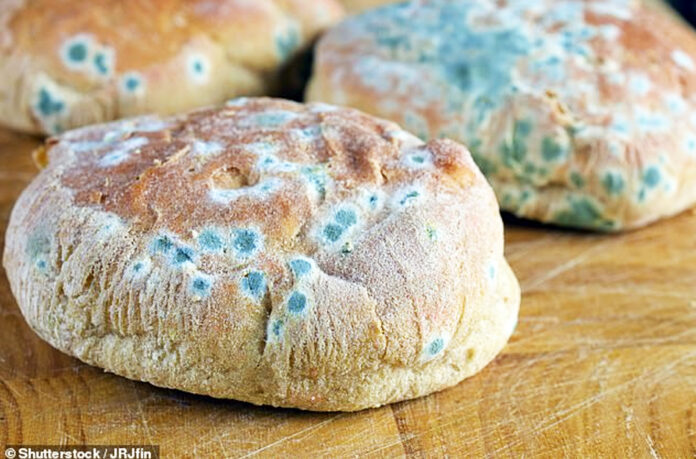Food that is obviously rotting or contains mould should not be eaten, according to the Food Standards Agency (FSA).
This advice is especially important for people in vulnerable groups, such as children, people who are pregnant, those aged over 65 and anyone with a weakened immune system.
Consuming mould — technically just a microscopic fungus — can make us sick.
Avoid mouldy grains, nuts and apples
Nuts, grains and apples can be some of the most dangerous food to eat, that is if you find a patch of mould on them, according to Dr Fuchs.
He said: ‘Consumers may be allergic to the moulds or develop respiratory conditions if exposed.
‘Secondly, moulds can produce toxic compounds called mycotoxins.’
Mycotoxins, described as ‘extremely dangerous’, can suppress the immune system and trigger reproductive problems.
Some have even been linked to cancer.
‘They will rarely have acute effects but they can over a long period of exposure,’ according to Dr Fuchs.
However, aflatoxin, the most harmful type of mycotoxin, is known to cause these severe complications.
It is produced by two species of mould — Aspergillus flavus and Aspergillus parasiticus — and may be found in mouldy nuts, rice, spices, vegetable oils and cocoa beans.
In large doses, aflatoxins can be life-threatening.
Patulin is another mycotoxin that can grow on rotting apples. If eaten it can cause ‘nausea, gastrointestinal disturbances and vomiting’, according to the World Health Organization.
Avoid mouldy soft cheese, berries and bread
While not all mould is this dangerous, it can still make you feel unwell if eaten.
To make matters trickier, the mould you can see on the surface of food isn’t the full extent of the problem, warns Dr Fuchs.
By this point, mould spores have already deeply invaded the product.
‘Moulds produce microscopic thread like structures called hyphae which can spread into the food,’ he said.
‘Therefore, what is visible on the surface may not be the full extent of the contamination by the mould.’
The softer the food, the easier it is for mould to penetrate its surface.
For example, food with a high water content, such as juicy berries, jam or even soft cheese encourages the mould to spread deeper.
Bread is another culprit, with its porous structure allowing hyphae to grow into it.
That means when you find a small patch of mould, it’s likely to be in the whole of the jar of jam or punnet of fruit, even if it is only visible on the surface.
But some cheeses ARE safe
One of the only foods you can eat even if it is mouldy is hard cheese.
‘Hard, dense foods like hard cheeses or firm fruits and vegetables are more resistant to penetration by the mould so the mould could be cut out and the food consumed’, he added.
To be safe Dr Fuchs recommends people cut off about 2.5cm of food around and below the mouldy area.
However, when mould is specifically used to make a product, such as blue cheese, it is safe to eat.
Credit: dailymail.co.uk









